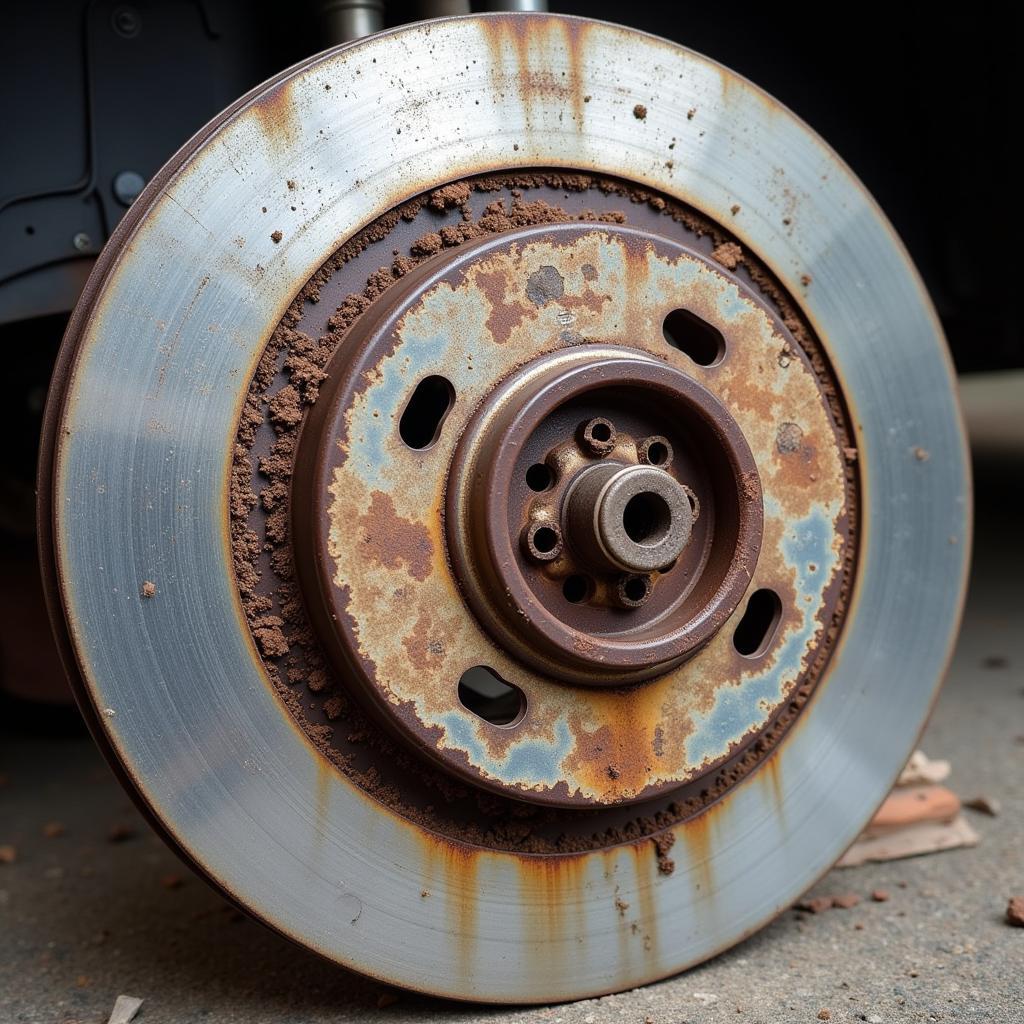Worn brake pads are a serious safety hazard. Knowing what do worn brake pads look like on a car is crucial for maintaining your vehicle and ensuring safe driving. This article will guide you through the signs of worn brake pads, how to inspect them, and what to do if you find they need replacing.
Recognizing worn brake pads isn’t always straightforward, but several key indicators can alert you to potential problems. One of the most common signs is a squealing or grinding noise when you apply the brakes. This often indicates that the pad’s wear indicator, a small metal tab, is contacting the rotor. Don’t ignore this sound! It’s a clear sign that your brake pads need immediate attention. You might also experience a decrease in braking performance, meaning you have to press the brake pedal harder to stop. This is a dangerous situation and shouldn’t be ignored. If you’re unsure about your brake pads’ condition, it’s always best to err on the side of caution and have them inspected by a professional. For more insights on brake warning lights, check out this helpful resource: dodge challenger brake warning light.
Signs of Worn Brake Pads
Several telltale signs indicate your brake pads might be worn. These include:
- Squealing or Grinding Noises: As mentioned earlier, this is often the first and most noticeable sign.
- Reduced Braking Performance: If your car takes longer to stop than usual or you feel a pulsing sensation in the brake pedal, your pads may be worn.
- Thin Brake Pads: You can visually inspect your brake pads through the wheel spokes. If they appear thinner than ¼ inch, they likely need replacing.
- Brake Warning Light: Many modern cars have a brake warning light on the dashboard that illuminates when the brake pads are worn. If this light comes on, get your brakes checked immediately.
- Vibration in the Steering Wheel: Worn brake pads can cause vibrations in the steering wheel when braking.
If you’re experiencing any of these issues with your Mini Countryman, you can find more specific information here: mini countryman brake pad warning light.
How to Inspect Your Brake Pads
Inspecting your brake pads is a relatively simple process. Here’s a step-by-step guide:
- Safety First: Ensure your car is parked on a level surface and the parking brake is engaged.
- Wheel Removal: Use a lug wrench to remove the wheel nuts and carefully take off the wheel.
- Locate the Brake Pads: The brake pads are located on either side of the brake rotor, a large metal disc.
- Visual Inspection: Check the thickness of the brake pads. If they are less than ¼ inch thick, they need replacing.
- Check for Uneven Wear: Ensure the pads are wearing evenly across their surface. Uneven wear can indicate other brake system problems.
- Reassemble: Carefully put the wheel back on, tighten the lug nuts, and lower the car.
Why Brake Pad Replacement is Important
Driving with worn brake pads is extremely dangerous. It significantly reduces your stopping power, increasing the risk of accidents. Furthermore, worn pads can damage the brake rotors, leading to more costly repairs. Regular brake pad replacement is an essential part of preventative maintenance, ensuring your safety on the road.
“Regular brake maintenance isn’t just about saving money; it’s about saving lives,” says John Smith, Certified Automotive Technician at Smith’s Auto Repair. “Worn brake pads can compromise your ability to stop quickly, putting you and others at risk.”
What to Do if Your Brake Pads are Worn
If your inspection reveals worn brake pads, it’s crucial to replace them as soon as possible. While you can replace them yourself if you have the necessary tools and experience, it’s often best to take your car to a qualified mechanic. They can ensure the job is done correctly and identify any other potential issues with your braking system.
For information on how to disable the brake warning light after replacing the pads, consult this guide: how to turn off brake warning light.
When Should You Check Your Brake Pads?
It’s generally recommended to have your brake pads checked every 12,000 miles or during your annual car service. However, if you notice any of the signs mentioned earlier, you should have them inspected immediately.
“Don’t wait for your brakes to fail completely before getting them checked,” advises Sarah Jones, Lead Mechanic at Jones Auto Services. “Early detection and prompt replacement of worn brake pads are vital for ensuring optimal braking performance and safety.”
If you own a Jaguar XE and are experiencing brake warning light issues, this resource can be helpful: jaguar xe brake pad warning light. For those dealing with brake warning light issues on a 2007 Dodge Ram 1500, this link might provide some clarity: 2007 dodge ram 1500 brake warning lights on.
Conclusion
Knowing what worn brake pads look like on a car is crucial for safe driving. By being aware of the signs, performing regular inspections, and taking prompt action when necessary, you can ensure your braking system is in optimal condition, keeping you and others safe on the road. Don’t underestimate the importance of regular brake maintenance – it’s a small investment that can make a big difference in your safety.

